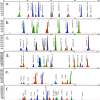SNP Miniplexes for Individual Identification of Random-Bred Domestic Cats
- PMID: 27122395
- PMCID: PMC5019183
- DOI: 10.1111/1556-4029.13026
SNP Miniplexes for Individual Identification of Random-Bred Domestic Cats
Abstract
Phenotypic and genotypic characteristics of the cat can be obtained from single nucleotide polymorphisms (SNPs) analyses of fur. This study developed miniplexes using SNPs with high discriminating power for random-bred domestic cats, focusing on individual and phenotypic identification. Seventy-eight SNPs were investigated using a multiplex PCR followed by a fluorescently labeled single base extension (SBE) technique (SNaPshot(®) ). The SNP miniplexes were evaluated for reliability, reproducibility, sensitivity, species specificity, detection limitations, and assignment accuracy. Six SNPplexes were developed containing 39 intergenic SNPs and 26 phenotypic SNPs, including a sex identification marker, ZFXY. The combined random match probability (cRMP) was 6.58 × 10(-19) across all Western cat populations and the likelihood ratio was 1.52 × 10(18) . These SNPplexes can distinguish individual cats and their phenotypic traits, which could provide insight into crime reconstructions. A SNP database of 237 cats from 13 worldwide populations is now available for forensic applications.
Keywords: Felis silvestris catus; animal forensics; forensic genetics; forensic science; single base extension; single nucleotide polymorphism.
© 2016 The Authors Journal of Forensic Sciences published by Wiley Periodicals, Inc. on behalf of American Academy of Forensic Sciences.
Figures



References
-
- American Pet Products Manufacturers' Association . National Pet Owner's survey. Greenwich, CT: The Association, 2012.
-
- American Veterinary Medical Association . US Pet Ownership and Demographics sourcebook. Schaumburg, IL: The Association, 2007.
-
- Louwerens M, London CA, Pedersen NC, Lyons LA. Feline lymphoma in the post‐feline leukemia virus era. J Vet Intern Med 2005;19(3):329–35. - PubMed
-
- Boehme A, Brooks E, McNaught I, Robertson J. The persistence of animal hairs in a forensic context. Aust J Forensic Sci 2009;41(2):99–112.
-
- D'Andrea E, Fridez F, Coquoz R. Preliminary experiments on the transfer of animal hair during simulated criminal behavior. J Forensic Sci 1998;43(6):1257–8.
MeSH terms
Grants and funding
LinkOut - more resources
Full Text Sources
Other Literature Sources
Miscellaneous

